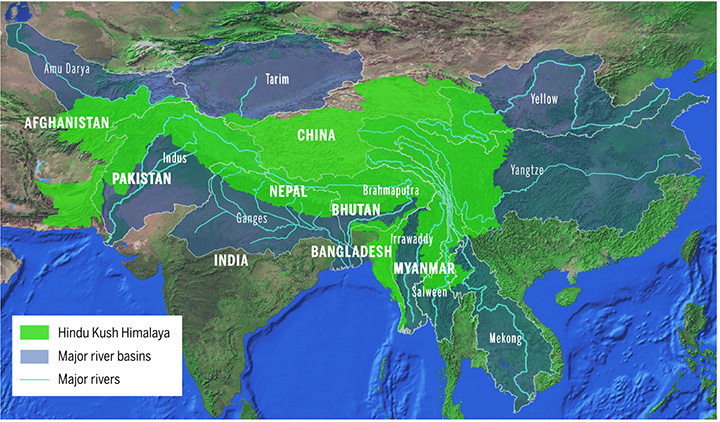Table of contents
The recent report by the International Centre for Integrated Mountain Development (ICIMOD) on the record low snow persistence in the Ganga River basin and other basins in the Hindu Kush Himalaya (HKH) region is a significant indicator of the accelerating climate crisis.

Historical Context
- The report analyzed data from 2003 to 2024 and found that 13 of the past 22 years have registered lower-than-normal seasonal snow persistence.
- The Ganga basin's previous lowest snow persistence was 15.2% below normal in 2018, while the highest was 25.6% above normal in 2015.
- The Brahmaputra basin's lowest snow persistence was in 2021 at 15.5% below normal.
Let's look deeper into the key aspects of this accelerating climate crisis:
What is Snow Persistence?
- Definition: Snow persistence refers to the fraction of time snow remains on the ground. It is crucial as the melting snow provides water to people and ecosystems.
- Importance: Snowmelt is a major source of water in the HKH region, contributing 23% of the runoff to the region’s 12 major river basins annually.
Geographical Scope

- The HKH mountains span approximately 3,500 km across eight countries: Afghanistan, Bangladesh, Bhutan, China, India, Nepal, Myanmar, and Pakistan.
- These mountains are known as the “water towers of Asia” because they are the origins of 10 major river systems, including the Ganga, Brahmaputra, and Indus.

2024 Snow Persistence Data

- Ganga Basin: Recorded its lowest snow persistence in 22 years, 17% below the long-term historical average.
- Brahmaputra Basin: Snow persistence was 14.6% below normal.
- Indus Basin: Snow persistence dropped to 23.3% below normal, the lowest in the past 22 years.
- Amu Darya Basin: Recorded its lowest snow persistence, 28.2% below normal.
- Helmand River Basin: Snow persistence fell to 31.8% below normal.
- Irrawaddy River Basin: Slightly below normal with a 2.4% decrease.
Geographical Trends
- The report highlighted a trend of decreasing snow persistence from east to west in the HKH region.
- The western part of the HKH region, which contributes the highest water supply to rivers, witnessed dramatically low snow levels.
Causes of Lower Snow Persistence
- Weak Western Disturbances: These are low-pressure systems originating over the Mediterranean, Caspian, and Black Seas that bring rain and snow to the HKH region in winter.
- Climate Change and Global Warming: These factors are causing instability in weather patterns, exacerbating conditions like La Niña and El Niño, which influence global weather patterns, including western disturbances.
Implications
- Water Supply: The decrease in snow persistence threatens water availability in early summer, particularly in the Indus basin, which relies heavily on snowmelt.
- Snowmelt contributes approximately 23% of the total water flow of 12 major river basins in the HKH region.
- Agriculture and Livelihoods: Reduced water availability can severely impact agriculture, which is a primary livelihood for millions in the region.
- Early summer water shortages could lead to drought conditions, affecting food security and livelihoods.
- Ecosystems: Altered water availability can impact local ecosystems and biodiversity, which depend on consistent water flow from snowmelt.
Mitigation and Adaptation Strategies
Climate Action
- Emission Reductions: Reducing greenhouse gas emissions is crucial to mitigate rising temperatures and their impact on snow persistence.
- Building Political Will: Building political will for ambitious climate action, especially among G-20 countries, is essential to protect the HKH region.
Water Management
- Water Infrastructure: Developing robust water infrastructure and policies to protect snowfall areas is crucial.
- Proactive Measures: Governments should activate drought management strategies and update water management plans to prepare for water stress.
- Drought Response Strategies: Organize relief activities during emergencies to ensure a clean water supply. Promote rainwater collection for irrigation and other relevant activities.
Regional Cooperation
- Sustainable Water Management: Promoting cooperation among HKH countries for sustainable water management.
- Transboundary Cooperation: Countries sharing transboundary rivers should collaborate to update water management laws and ensure long-term resilience to climate change.
- Enhanced Collaboration: Promote regional cooperation for sustainable water management and climate adaptation strategies.
Environmental Restoration
- Reforestation: Planting native tree species can help the ground retain more snow.
Forecasting and Communication
- Improved Weather Forecasting: Better forecasting and early warning systems can help communities prepare for water stress.
- Effective Communication: Relevant agencies should communicate the situation effectively and notify communities of the risks.
Conclusion
The record low snow persistence in the Ganga, Brahmaputra, and Indus river basins in 2024 is a stark reminder of the accelerating climate crisis. For UPSC preparation, it is essential to understand the scientific, environmental, and socio-economic dimensions of this issue. This includes the causes of changing snow persistence patterns, their implications for water resources and livelihoods, and the strategies needed to mitigate and adapt to these changes.
Source: The Hindu
